Back in the spring Forrester released a report that predicted that enterprise spending on Web 2.0 technologies will grow to $4.6 billion by 2013. Since they estimate $764 million in 2008, that’s a high rate of growth! That alone is interesting, but what I thought was especially interesting was the fact that they find enterprises currently spending more on internal uses of Web 2.0 tools than on customer-facing uses. Forrester expects that trend to reverse by next year, with customer-facing uses taking precedence and growing faster over the next five years. You'll find more detail here.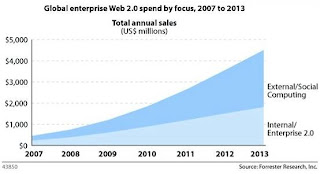
 McKinsey has just released a study that sheds more light on what’s going on. They also find companies using Web 2.0 tools more for internal purposes than for external. Web services leads the way because this collective set of tools makes it easier to exchange information and conduct transactions; the importance of both being obvious. Nevertheless, the lowest rate of usage is with partners and suppliers where both information sharing and ease of transactions are key to smoothly-functioning supply chains.
McKinsey has just released a study that sheds more light on what’s going on. They also find companies using Web 2.0 tools more for internal purposes than for external. Web services leads the way because this collective set of tools makes it easier to exchange information and conduct transactions; the importance of both being obvious. Nevertheless, the lowest rate of usage is with partners and suppliers where both information sharing and ease of transactions are key to smoothly-functioning supply chains.
The McKinsey study also finds differences in satisfaction with results of using Web 2.0 tools, with only 21% extremely or very satisfied with their experiences with both internal and external uses. There are also substantial global differences in the use of tools (enterprises in the US are more likely to use social networks, for example). They note that the list of tools was expanded for this study; I wonder if that will be an annual occurrence! The entire report can be accessed on the McKinsey Quarterly site (free registration required).
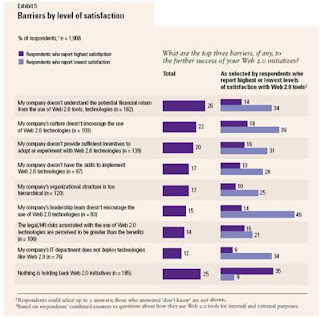 One of the breakdowns by satisfaction level concerns the barriers to successful deployment of Web 2.0 tools. None of them are surprising--except maybe that 25% say there are no barriers. Only 15% of respondents say that the leadership of their companies doesn’t encourage the use of Web 2.0 technologies, but 49% of respondents who are not satisfied with their Web 2.0 results say that. Why does that not surprise me!
One of the breakdowns by satisfaction level concerns the barriers to successful deployment of Web 2.0 tools. None of them are surprising--except maybe that 25% say there are no barriers. Only 15% of respondents say that the leadership of their companies doesn’t encourage the use of Web 2.0 technologies, but 49% of respondents who are not satisfied with their Web 2.0 results say that. Why does that not surprise me!
I see two major take-aways from these two important studies:
1. Internal use of Web 2.0 technologies provides important benefits to the enterprise. Improving business operations in a variety of ways is the obvious one. Making the enterprise comfortable with the technologies and the changes they require—in management and in dealing with customers—is less obvious but perhaps more important in the long run.
2. The leadership of top management is needed to facilitate the adoption of Web 2.0 tools in the enterprise. Without it, there will be less use of important new technologies and the uses that are implemented will have less satisfactory results.
Important lessons about marketing in the Web 2.0 world have been reinforced once again!
Thursday, July 31, 2008
Use of Web 2.0 Tools
Posted by MaryLou Roberts at 11:47 AM 0 comments
Labels: B2B, marketer response to social media, new media, social media, web 2.0
Tuesday, July 29, 2008
Knol--An Alternative to Wikipedia?
When I made my last post on Thursday there was a post on my Google dashboard about a new product just entering Beta—a Knol. It looked interesting, so I did some investigating. Of course, being a writer, I couldn’t resist writing a Knol.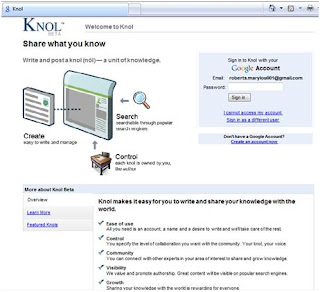
A Knol uses some of the same technology as Blogger, but it has a different purpose. Knols are to be authoritative articles on a single subject. There are quite a few listed already; my guess is that some may have been imported and others written specifically for Knol. I found one listing called “Encyclopedia,” which seems to suggest Google’s intent.
Knols really work like Google Documents and have some of the same features. You can write, save, and collaborate. Notice that I can invite authors and reviewers to my just-begun Knol. I saved but didn’t try to publish it, because it was incomplete. I’m sure that publication would be the point where they would ask me to establish my credentials, which I don’t think would be a problem. However, individual articles are vetted and categorized, and I’m sure they wouldn’t take this one-sentence beginning. 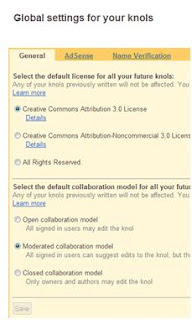 Notice on the third screen capture that they are encouraging Creative Commons 3.0 licensing, which essentially says that readers can use the material as long as they give proper attribution. That seems to be the emerging standard for web content of many kinds, and it makes sense to me.
Notice on the third screen capture that they are encouraging Creative Commons 3.0 licensing, which essentially says that readers can use the material as long as they give proper attribution. That seems to be the emerging standard for web content of many kinds, and it makes sense to me.
In a lot of ways this is just an extension of Google docs, which I use and really like. They are great for getting work done, but not so great for being found. There are also no standards for format or content of Google docs, and Google clearly wants Knols to be respected for their informational content. Knols are searchable from the Knol site and from a Google web search. From the Google toolbar I searched for one of the featured Knols using (and misspelling, as usual) the exact title, and it came right up.
Will this become an alternative to Wikipedia? Will it be more respected in terms of the quality of its content? Only time will tell. In the meantime, it provides a good platform for people who have something to say and wish to encourage their colleagues to contribute. Since it can be closed, it provides a forum for internal corporate documentation on specific subject matter.
My Knol on social media could be a good one. Would anyone like to contribute a case study or their own observations on the subject? We could write something together!
Posted by MaryLou Roberts at 8:53 AM 0 comments
Labels: collaboration, marketer response to social media, web 2.0, wikis
Thursday, July 24, 2008
Who Owns the Social Network?
I’m still scratching my head over an article I found in a recent newsletter from Foviance, a British customer-experience firm. It describes a recent British court decision that awarded partial contents of an employee’s social network to his employer. The employeer, Hays Specialist Recruitment, is an executive recruiting firm. The former employee, MarkIons, had set up his own recruiting firm before leaving Hays and used the LinkedIn network he built while in the employment of Hays to solicit business for his new firm. According to the British Computer Weekly (note two interesting links at the bottom of this article):
The employeer, Hays Specialist Recruitment, is an executive recruiting firm. The former employee, MarkIons, had set up his own recruiting firm before leaving Hays and used the LinkedIn network he built while in the employment of Hays to solicit business for his new firm. According to the British Computer Weekly (note two interesting links at the bottom of this article):
A court judgment ordered Ions to disclose his LinkedIn business contacts and all e-mails sent to or received by his LinkedIn account from the Hays computer network, but stopped short of requiring him to disclose his entire database of clients, as requested by Hays.
Interesting, as is another article referenced by Foviance in the Times Online in which employees were urged to keep business and social network contacts separate. One, that’s hard to do; and, two, if your business and personal life is as entwined as mine is, you wouldn’t want to anyway.
The Foviance newsletter pointed out that the articles it referenced did not comment on implications beyond this case. The fact that the firms involved are recruiters is probably important, even though contacts are the life blood of other industries also. I wonder if it mattered to the court that the employee had started his business while still employed by Hayes. This seems counter to what is going on in the US. Not only are there
This seems counter to what is going on in the US. Not only are there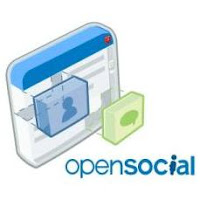 networks springing up all over the place, especially the B2B verticals, there are efforts to move data seamlessly between them. I’ve written about FriendFeed and OpenSocial. There is, in fact, a trade organization devoted to the subject.
networks springing up all over the place, especially the B2B verticals, there are efforts to move data seamlessly between them. I’ve written about FriendFeed and OpenSocial. There is, in fact, a trade organization devoted to the subject.
So I bring up the issue without knowing whether it is--or will become--a problem. If it does, I don’t know what the best solution would be. But social networks are here to stay, and the business vs. the personal use of them may create issues that need to be considered.
Posted by MaryLou Roberts at 11:31 AM 2 comments
Labels: British Internet Marketing, LinkedIn, OpenSocial, social networks
Wednesday, July 23, 2008
The Growing Importance of Cocreation
I recently wrote about DoubleClick’s effort to get users to help design their new site. That’s an application of what is often called cocreation. The current edition of the McKinsey Quarterly has an interesting article on the subject (note related articles listed on the sidebar).
Their thesis is that cocreation is in its early days and companies are trying to determine how best to take advantage of the collective wisdom of their customers. Amen to that! According to the article,
Our research suggests that 25 percent of Western Europe’s Internet users now post comments and reviews about consumer products of all kinds (exhibit). User-generated media sites are growing in numbers of visitors and participants by 100 percent a year, traditional sites by perhaps 20 to 30 percent. (p 6)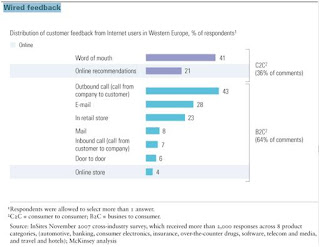
This chart also once again illustrates the importance of word of mouth as well as the importance of soliciting consumer feedback, especially by outbound phone calling. The growing number of customers who are willing to interact with companies online is obviously of great importance.
Their research into uses of Second Life suggest that 1 in 10 members is already cocreating with companies, mostly helping to design new products and services. They go on to say that most of their respondents didn’t know that was a possibility and, when informed, 60% would be willing to interact with corporate entities. I’d add ones that they trust and in situations where they see benefit from the interaction.
If you have any doubt that the same phenomenon applies in the US, download the “User Reviews a Must” whitepaper from PowerReviews. In it PetCo VP of E-Commerce, John Lazarchic says:
“No matter how many reviews they receive customers continue to add their voice. A product may already have a rating of 4.9/5 but someone will still write another positive review.”
Wow!
The McKinsey article also identifies issues that need to be dealt with in creating community to participate in cocreation. They are:
•Attracting and motivating cocreators
•Structuring problems for participation
•Governance mechanisms to facilitate cocreation
•Maintaining quality
I’ve frequently pointed out that not all audiences are willing to participate (think older consumers) while some are eager to take part in collaborative efforts (think members of B2B vertical markets).
Looking around the web to see who else was talking about cocreation, I came across  Cisco’s Executive Thought Leadership page and an interview with Prof. Thomas Malone of the MIT Center for Collective Intelligence. He points out that, as a result of the ability to share information at low cost, businesses can enjoy the economic benefits of large scale coupled with the human benefits of small scale which include flexibility and decision-making power. It’s a video worth watching. As you can see, there are other interesting ones on the site.
Cisco’s Executive Thought Leadership page and an interview with Prof. Thomas Malone of the MIT Center for Collective Intelligence. He points out that, as a result of the ability to share information at low cost, businesses can enjoy the economic benefits of large scale coupled with the human benefits of small scale which include flexibility and decision-making power. It’s a video worth watching. As you can see, there are other interesting ones on the site.
Is focused cocreation perceived to have some of the same dangers to the brand—mainly that people will say bad things—that opening to comments and ratings has? Maybe. However, good cocreation, as McKinsey suggests, directs the collective energy to making positive suggestions for the future. I’m confident it also leads to further bonding with the brand. Why not? The customer now has a stake in resulting products and services. That’s two highly desirable outcomes!
Posted by MaryLou Roberts at 12:10 PM 0 comments
Labels: B2B, collaboration, community, consumer reviews, user created content
Tuesday, July 22, 2008
Herding Virtual Sheep
 Last Friday I noticed an article on MediaPost about a new product to allow the creation of branded virtual worlds. I imagine a lot of marketers would have the same two questions I did:
Last Friday I noticed an article on MediaPost about a new product to allow the creation of branded virtual worlds. I imagine a lot of marketers would have the same two questions I did:
1.Why?
2.Who cares?
So I spend some time over the weekend exploring The Electric Sheep Company and some of their applications. The exploration turned up some interesting information.
The company is over 3 years old and has built virtual worlds for various clients on existing platforms like SecondLife. The WebFlock product, according to founder Sibley Verbeck, is “a tool set for embedding flash-based virtual spaces within Web sites and integrating those into any existing Web applications. . . Primarily we see it as enabling virtual spaces for casual audiences who are already coming to a given Web site.” The first WebFlock project is a virtual world for Showtime’s The L Word series, which I’d guess has an audience that would enjoy the interaction a virtual world will offer.
But that doesn’t answer the broader “why” question. I looked farther; not difficult, since Electric Sheep has a robust Flickr site (why don’t more companies take advantage of sites like Flickr to demonstrate product use/happy customers?). I see projects for the NBA Finals (broadening the customer experience, as I remember), the USG Division of Siemens (looks like a virtual pavilion in Second Life), Best Buy’s Geek Squad (what it’s like to be a Geek Squad member), a Starwood hotel under construction (a preview of a new “select service” concept under construction at the time), and many others. Many are targeted at a young adult audience, but companies like USG/Siemens and IBM clearly have a business audience. If you look carefully, you see that many of them are either event- or entertainment-oriented. The content also makes sense.
If there are reasonable strategic answers to “why,” that still leaves the issue of whether website visitors will use them. These are corporate applications; I’m sure the owners know but equally sure few will reveal any specifics. I did find some more general information about virtual worlds, however, that suggests there is more going on in this space than most of us probably know about.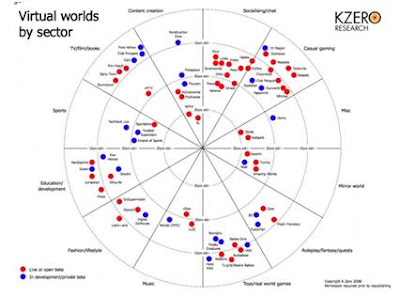
KZero, a British research firm that specializes in virtual worlds, has a graphic of the virtual world space. It’s segmented by content type and shows whether each world is open or in private beta. There is a lot going on, even though it doesn’t appear to cover the short-lived event and other branded worlds. And, yes, I know it’s small and hard to read. The good news is that they have this data broken out by content type and also by age group. It’s interesting reading.
MediaPost notes that a company can expect to spend less than $100,000 for a branded virtual world using this platform. If you have a good reason for doing it, and an audience that is willing to participate, that’s not much in the greater universe of media expenditures. WebFlock is an interesting development that’s worth watching.
Posted by MaryLou Roberts at 12:47 PM 0 comments
Labels: social media, social media strategy, virtual worlds, web 2.0
Thursday, July 17, 2008
Basho EMail Promotes Community
Not long ago I wrote about Basho Technologies, a sales training firm in Cambridge, MA, that has a robust approach to building community on its website. Later I commented that B2B community makes a lot of sense—people are motivated to join communities that offer them value, and good B2B communities can offer useful job-related benefits.
A few days ago I got their e-newsletter and realized they were using it in an interesting way. Most corporate newsletters offer information and try to get you to buy things. Basho is using this edition to help build their community. There’s some selling, but it’s extremely soft.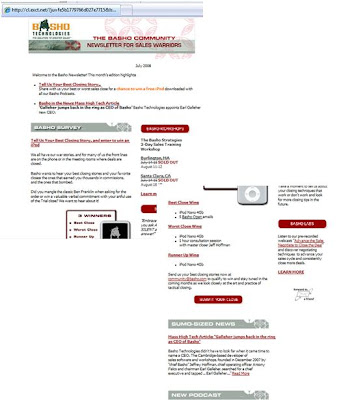
The main feature is a contest for the best sales close; there will be a runner up. But there’s also a category for “worst.” We can learn a lot from mistakes (hopefully other people's, not ours!), so that’s a great idea. I also love the prize; it includes a free hour of consultation with one of their sales trainers. Oh, yes; it includes an iPod Nano, just like the other two categories. I’d love to know how many responses they get; something tells me that the response will be substantial.
Is their approach working? There are two workshops listed on their newsletter. Both are sold out. That should mean something.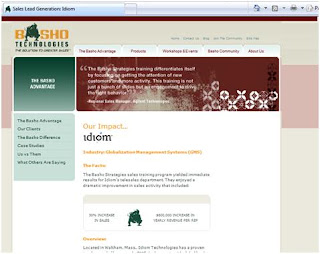
When I clicked through, I got a landing page with a reasonably detailed case study instead of their home page, which I thought was interesting. That’s nice integration at a time when they are (were, actually) promoting workshops.
I’m enjoying following this company. They have a thoughtful approach to marketing their service. They also have a sense of humor. What more can you ask for in the enervating days of high summer? Year-round—what more can you ask for in a community of sales warriors?
Posted by MaryLou Roberts at 11:13 AM 2 comments
Labels: B2B, community, email marketing, integrated marketing communications, social media strategy
Wednesday, July 16, 2008
Surround Marketing
I’d like to introduce a concept developed by Arun Poojari. Arun is the National Sales Head - Brand Solutions for Microsoft Advertising in India. His Surround Marketing is clearly a new media concept. The title is reminiscent of the surround session media buy offered by publishers including The New York Times, but it’s much broader.
The media model he uses is Entertain > Connect > Inform > Assist > Convert. It bears some relation to the one I wrote about several months ago, but it focuses only on acquisition. That’s find, since the purpose is to look at new media in the acquisition process.
And that’s an interesting perspective. His stages and the techniques in each are:
•Entertain. Use video, games, and/or rich media
•Connect. Banner advertising, which can be on social networks or other sites like portals. Social networks can also host marketer pages; Target is a good example. So can virtual worlds, which Arun doesn’t have on this graphic.
•Inform. Email, mobile advertising and applications of many types sit squarely on the line between Connect and Inform. They can be used for either purpose, perhaps both at the same time. Special events and other on-line promotions can be highly informative.
•Assist. Organic search is often the first step in finding out about products and services and the brands that offer them.
•Convert. He sees paid search as closer to the end of what we used to call the conversion funnel. Paid search should be coupled with campaign-specific landing pages and a clear conversion strategy and path.
This is a content ecosystem, not the conversion funnel of olden days (a decade or so ago). The conversion funnel could be controlled by a savvy marketer. No one controls the ecosystem of content, which includes but certainly is not limited to, marketer messages. Content of all kinds, much of it user created, swirls around in rather fashion. Marketers can be—must be—part of that ecosystem, but they cannot control it.
Today’s marketer wants to use the new media to reach certain target audiences. The Sears ArriveLounge campaign I wrote about yesterday is a good example. Sears is using the large social network portals as well as audience-specific networks. That’s good, but are there other places on the Internet where this target audience hangs out? Undoubtedly. I’d suggest that no media buy is going to cover them all, even for a deep-pockets marketer. If your online budget is not robust, a media buy covering all sites is unlikely.
That puts a premium on engaging the audience so they’ll share with their friends. Everyone is trying to do that—at least everyone puts a share this link or icon on their communications. That’s the facilitator, but it’s not enough to get the potential customers you do reach to help you reach others that haven’t been reached yet. That requires content that is actually worth sharing.
And that’s the challenge in a nutshell!
Posted by MaryLou Roberts at 1:51 PM 1 comments
Labels: customer acquisition, customer conversion, new media, social media strategy, social networks
Tuesday, July 15, 2008
Sears Goes Virtual
Sears is not known for being either fashion forward or a particularly desirable destination for teen fashionistas. An article in AdAge (subscription required) yesterday points out that they are trying to change that. They have created the ArriveLounge (I don’t have a clue about the implications of that name) as the centerpiece of the campaign for fall back-to-school. Here’s the top and bottom halves of the web page so you can look at it and make your own judgment about whether this will attract the teen and tween crowd. The AdAge article points out that Sears is partnering with sites including MySpace and Disney for custom content and sponsorships, creating games with a number of partners, and that they will have events such as fashion shows in virtual world where teens can also create their own avatars and clothe them in Sears garments.
The AdAge article points out that Sears is partnering with sites including MySpace and Disney for custom content and sponsorships, creating games with a number of partners, and that they will have events such as fashion shows in virtual world where teens can also create their own avatars and clothe them in Sears garments.
The virtual worlds aspect intrigued me, because there was a list of sites that—not surprisingly—I had never heard of. So here’s a quick rundown:
•Zwinky is a portal of the IAC division of InterActive Corp. It is fashion-oriented and offers a variety of ways to be creative and expressive.
•Meez, a brand of Donnerwood Media, promotes the creation of avatars, which would offer opportunities for trying on Sears clothing.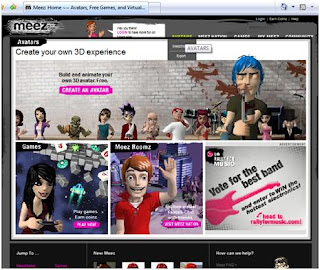

•WeeMee is a WeeWorld social network that lets members interact through their WeeMees. What’s a WeeMee? “It's a cartoon that looks just like you. Think of it as your own personal avatar or icon.”
•The N is a brand of Nickelodeon Kids and Family, which is part of Viacom. Nickelodeon has experience in experience in virtual worlds and has a robust strategy for creating and monetizing virtual world that feed off their successful TV series and characters.
•Poptropica is part of Pearson’s Family Education Network. As you can see from the graphic, a “Costumizer tool” is prominently featured on their home page.
There may be more social networks in this teen/tween space, but these are the ones Sears has chosen for the Arrive Lounge campaign. Their media choices seem reasonable. The key to success will be how well they engage their target audience.
Several months ago I wrote a series of posts for eBrandMarketing about the “Mommy Ecosystem.” This strikes me as the same sort of social and marketing phenomenon. These teens and tweens are highly social creatures, so social networking is a big part of their lives. Not surprisingly, a number of networks that are more highly targeted than, say, MySpace has grown up to take advantage of the phenomenon. Marketers who target the segment clearly want to make use of these networks, as they must do to reach their target audience. However, they have to reach these young men and women on their own terms, not the marketer’s terms. That’s not easy. Sears doesn’t seem to have made any major missteps so far. It will be fun to keep an eye on this campaign and see if it does connect with this difficult-to-reach target market.
Posted by MaryLou Roberts at 12:40 PM 0 comments
Labels: avatars, Internet advertising, online advertising, social media, social networks, virtual worlds
Thursday, July 10, 2008
Testing Critical to Internet Marketing Success
Last week I wrote about diy display advertising and pointed out that all interactive advertising and promotion offers marketers a splendid opportunity to test various approaches. That can include many marketing issues from competing email subject lines to competing messages or creative in a display ad to alternative landing pages and more.
Testing is a fundamental technique of direct marketing, but mass media marketers rarely had the opportunity to test. They have been slow to acquire the skill as some of their marketing has moved onto the web. Marketing programs can be much improved by skilled testing; it’s a skill that needs to be acquired.
In fact, many marketers are foggy about the difference between marketing research and testing. Both have their place in a well-run marketing program. However, in an interactive environment, I argue strongly that testing should come first. There are several reasons:
•Testing answers the question, “what works?” and gives a strong basis for good marketing decisions.
•Testing is faster.
•Testing is cheaper.
Testing, however, cannot answer the “why” questions--why customers think and do what they do. That’s where marketing research comes in. It’s also the reason that I argue to test first and find out what works, then ask “why” if and only if you need the answer to improve decision making. Testing also requires a certain degree of technical skill to ensure the test is run properly and read correctly. In the earlier post I recommended Paul Berger’s chapter on testing in our
Testing also requires a certain degree of technical skill to ensure the test is run properly and read correctly. In the earlier post I recommended Paul Berger’s chapter on testing in our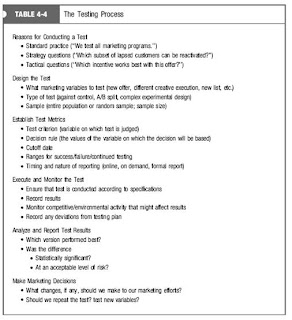 direct marketing book. Paul is a superb statistician and his approach is based on classical hypothesis testing. You may find the outline familiar from your own statistics course. I developed a companion concept for my Internet marketing text that emphasis the managerial aspects of testing. The truth is that both perspectives are key to conducting valid tests.
direct marketing book. Paul is a superb statistician and his approach is based on classical hypothesis testing. You may find the outline familiar from your own statistics course. I developed a companion concept for my Internet marketing text that emphasis the managerial aspects of testing. The truth is that both perspectives are key to conducting valid tests.
Let me give just one example—the free membership trial from the Marketing Sherpa site. The test was conducted by Marketing Experiments, and you can access commentary and the full presentation via their blog. This test is a simple A/B split in which existing sign-up page A is tested against new sign-up page B. In this case A is the sign-up page currently in use, so it becomes the control (baseline) and the question is, “Does B work better than A?” A control (no treatment in experimentation parlance) is not strictly required in an A/B split. Then the question is, “Does A or B work better?”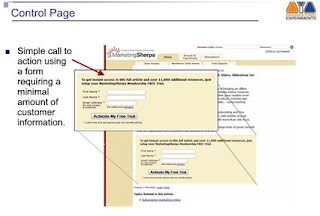
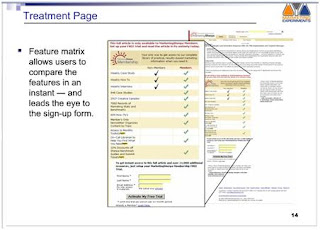
In this case the control included a fairly generic paragraph about the benefits of membership and requested a minimal amount of information for signup. The treatment page included a feature matrix that detailed the content available free to newsletter subscribers and additional content available to members of Marketing Sherpa. The information required was the same; the difference was in the amount of information given to the potential registrant.
The test was run over a 30-day period and the metric used was conversion rate. More  information did work, in spite of the fact that it led to a longer, more complex page. It improved conversion by more than half a percent, which—given generally low conversion rates—is huge.
information did work, in spite of the fact that it led to a longer, more complex page. It improved conversion by more than half a percent, which—given generally low conversion rates—is huge.
What Marketing Sherpa has done with it is interesting. Instead of simply using the features listing, it has a page for each feature as part of the process. That would be deadly if you had to go all the way through in order to sign up for the free trial membership. The sign-up box is on each page, so the minute the visitor is convinced, she can enter her information. If not yet convinced, she goes on to the next page. Clever!
I’d encourage you to view you can access Dr. McGlaughlin’s entire presentation. It gives two other good examples. You can also find testing articles on GrokDotCom and examples of various types of testing on Omniture’s Offermatica site.
Whether the marketer uses marketing support services or chooses to develop testing expertise in house, it is an essential skill for the Internet age.
Posted by MaryLou Roberts at 12:15 PM 4 comments
Labels: experimentation, internet marketing, online advertising, testing
Wednesday, July 9, 2008
Loopt--Looking for Customers in New Media
In April I wrote about the social network for mobile, Loopt. I commented that there was clearly interest among people much younger than I; I’ve had several students develop marketing plans for a company that would connect mobile users. It seemed like an idea whose time had come.
On Monday MediaPost had an article on Loopt’s new customer acquisition program. Not surprisingly, it’s a new media program. Basically they are sponsoring the popular Black20’s Middle Show hosted by David Price. There are probably several things in that sentence that need translation anyone over 35, and perhaps some under. Black20 is a start-up that makes and broadcasts daily videos. The New York Times has a great story—the founders, where the name came from, how they do what they do. The Middle Show is their popular version of late-night comedy. It is hosted by David Price, recently named by New Media Minute as the “Sexiest Web Host.” I found the announcement on a site called The Feed that bills itself as “The Only News You Need to Know.” Pardon me if I take that with a grain of salt, but I hope you’re up to speed now.
I found the first sponsored episode of The Middle Show on YouTube. The video was posted on July 3 (this is July 9) and has 3,400 views, 26 ratings (4.5 stars out of 5), and 15 comments. Mull that. Some of the commenters are annoyed about the commercial aspect, but they really do appear to like this program. With that in mind, it’s worth devoting 4.35 minutes to viewing the video. I’m not sure this is ‘best in show’ new media advertising, but it does integrate the product into the story line—such as it is. Having watched it, are you inclined to “friend” David on Loopt?
posted on July 3 (this is July 9) and has 3,400 views, 26 ratings (4.5 stars out of 5), and 15 comments. Mull that. Some of the commenters are annoyed about the commercial aspect, but they really do appear to like this program. With that in mind, it’s worth devoting 4.35 minutes to viewing the video. I’m not sure this is ‘best in show’ new media advertising, but it does integrate the product into the story line—such as it is. Having watched it, are you inclined to “friend” David on Loopt?
The videos are going to appear on other social sites like Facebook and MySpace. Those make sense. New York’s TaxiTV seems to make less sense in terms of the target audience, but it’s clearly new media.
I know there’s a profound marketing implication here; I’m just having a little trouble finding it in the context of new media programming. Seriously, that is the implication. Loopt clearly has gone where its audience is. They’ve recruited a popular figure in that space to deliver their message. Have they got the message right? That remains to be seen. I agree with some of the commenters that it’s rather heavy-handed promotion. Will the product promotion fade more gracefully into the content of the show as time goes on? Time will tell!
Posted by MaryLou Roberts at 12:50 PM 0 comments
Labels: interactive advertising, mobile, mobile marketing, new media, social media, video
Tuesday, July 8, 2008
Demographics and Internet Behavior
If you missed Peter Francese’s analysis of 2007 Census data yesterday in AdAge, you should read it in its entirety. His focus is on the impact on brands with little specific about Internet behavior. I recently reported on a survey by AARP that shed light on the Internet behavior of older Americans, and Marketing Charts followed a few days later with some good graphics. Today they have material from a Stores study of Boomers. Boomers are generally considered to have been born between 1946 and 1964. That means they are now 44 to 63 years of age.
Let’s mash some of the data together. Quoting Francese: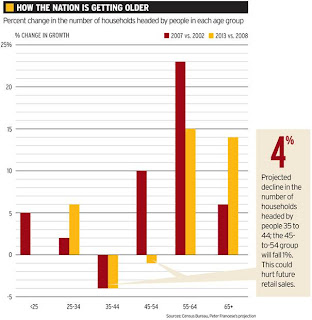
“The average U.S. head of household is now nearly 50 years old (49.5, to be precise). But here's the bigger story: More than 80% of the growth in the number of households in the next five years will be among those headed by people 55 and older.” In other words, the average head of household is a Boomer.
What does their media behavior look like, according to the Stores study and report in Marketing Charts:
Television:
•95% watch TV, with 77% of their viewing occurring between 7:30 pm and 11 pm.
•Two-thirds subscribe to cable TV and are most likely to watch Discovery Channel, A&E, the Food Network, ESPN and Fox News.
•They don’t like reality shows.
Radio:
•76% listen to the radio - more than any other demographic.
•49% listen to the radio during morning-drive time.
•Radio programming preference varies, from oldies to country to talk formats.
•6% subscribe to satellite radio.
Newspaper:
•57% read their local daily newspaper regularly.
•68% read their weekly community paper.
Internet:
•87% surf the internet, spending an average of 123 minutes online daily.
•93% regularly or occasionally use the internet to research products before they buy them.
•46% say online searches are triggered by traditional advertising or an article they’ve read; 45% are prompted by television or other broadcast media. 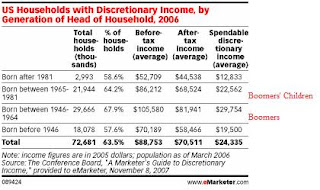
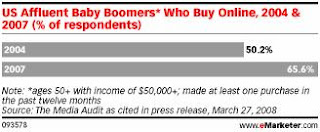 Add in the fact that Boomers have the highest discretionary income of any age cohort and that they are willing to buy online (eMarketer, April 10, 2008). The Internet is clearly a channel for reaching the ready-to-spend Boomer group.
Add in the fact that Boomers have the highest discretionary income of any age cohort and that they are willing to buy online (eMarketer, April 10, 2008). The Internet is clearly a channel for reaching the ready-to-spend Boomer group.
Francese has a wonderful quote on their spending behavior relative to their children: “Households headed by people under 35 [born before 1973] account for only a little more than a fifth of consumer spending by themselves, but they cause vast spending by others on their weddings and babies. There really should be a separate category in the national GDP figures for competitive grandparenting by baby boomers.” Ouch! But it’s a natural; affluent Boomers spend on many things; spending on their grandchildren is one of the most enjoyable.
Marketers need to confront the fact that Boomers and Seniors are active on the Internet. They both acquire information and make purchases there. It seems to me there may be a difference when it comes to entertainment, though. It may be a reason for the non-linear behavior I pointed to a few days ago.
Most Boomers are still working. Their Internet behavior may be more instrumental—whether content on e-commerce is their intent. They need to accomplish things. Seniors are more likely not to be working, more likely to have time to browse the Internet. So their behavior may have more expressive components that that of Boomers. Think about it!
Posted by MaryLou Roberts at 12:19 PM 0 comments
Labels: demographics, internet marketing, new media, segments
Thursday, July 3, 2008
B2B--Monetizing Social Media Sites
As I’ve written about B2B sites Basho and Mfg.com in recent weeks, it has occurred to me that businesspeople—either sellers or buyers—have good reasons for being involved in the communities of leading sites in their industries. It’s a matter of networking, spotting trends, and often actual problem solving.
Yesterday’s post gave a good example of a site moving in that direction—the use of AdReady’s platform to provide self-service advertising on the New York Times site. It reminded me of a recent blog post by Josh Bernoff of Forrester. He argues that the real business model for social media is B2B, not B2C. He has a good point.
His post is well worth reading in its entirety. I’ll summarize the objectives he says social media applications can accomplish for marketers and lists agencies who specialize in each activity. There are five major ones:
Listening. When people in an industry get together—in real or virtual worlds—they talk about their businesses.
Talk. Marketers should “join the conversation” to use Joseph Jaffe’s apt phrase.
Energizing. Allowing customers to interact and contribute energizes them. One-way communications no longer do the job.
Supporting. Good corporate knowledge bases have long contained major components of user-generated materials. Support forums are the newer, more interactive version. Lithium Technologies is one firm that offers a support form product. They say it allows businesses to:
• Identify experts
• Reward experts
• Track and measure effectiveness.
This is reminiscent of Eric VonHipple’s lead user concept, long a mainstay of B2B marketing. The support formum automates an important B2B concept. Here’s a shot of a Symantec forum supported by the Lithium platform. Note the activity mid-day before a long summer weekend!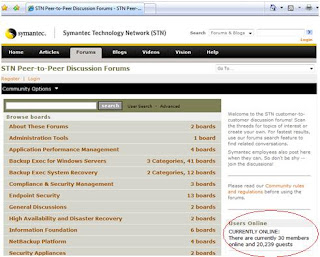
Embracing. Bring customers in; make customers part of the solution (not the problem). Think Dell’s Idea Storm site.
I can’t quibble with Bernoff’s contention that B2B is where the monetization is in this space. Some of the business models I’m seeing are operating first in the B2C space, then moving into B2C. That may suggest using the consumer market to demonstrate that the concept works before moving into the B2B space. It may just suggest that Internet businesses are figuring it out as they go along.
Whatever the process, new businesses in the social media space would do well to consider Bernoff’s advice!
Posted by MaryLou Roberts at 11:45 AM 0 comments
Labels: B2B, community, social media, social media strategy
Wednesday, July 2, 2008
DIY Advertising Takes Off
When I wrote about AdReady several weeks ago I set up an account to keep an eye on this interesting self-service display advertising concept. We’ve gotten used to this process with Google AdWords, and AdReady has services like a library of standard ads that make DIY banner advertising a reality. Following the model of AdWords, you can set your own advertising budget and monitor campaign results.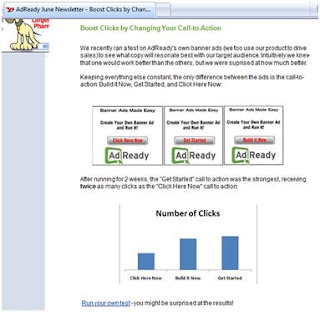
Because the system is easy to use, it’s easy to test competing ad messages. In their June newsletter, AdReady gave an example of running a test on an advertising button of its own. It’s a nice, clean test, with the only change being the call to action. I’d have guessed that “Click Here Now” was a fairly weak call to action, but personally, I’d have thought “Build it Now” would outperform “Get Started.” That’s why marketers should run tests! If you’d like a direct-response testing primer, please read the free testing chapter from Paul Berger’s and my direct marketing text. There is additional testing material in my Internet marketing text; I’ll do a post on that soon, because it’s an important tool.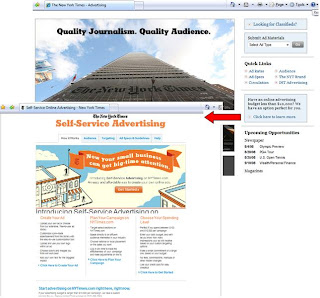
So—with AdReady you can create your own ads and test versions. Now you can do it on the New York Times site. It seems like a no-brainer. Small advertisers are not worth the time of the advertising department, but, in the aggregate, they could provide another significant revenue stream. Why not give them self-service capabilities? Using the AdReady platform, that’s just what the NYT has done.
For publisher sites that need to add revenue streams—and who doesn’t—this is an interesting option. For sites that are free to the user, like AdReady and so many others, it has something interesting to say about monetizing the site.
That leads me directly to what I’m planning to write about tomorrow. Please stay tuned!
Posted by MaryLou Roberts at 12:17 PM 0 comments
Labels: business models, display advertising, diy, Internet advertising, newspapers, online advertising
Tuesday, July 1, 2008
Ask Users to Help Design Site?
From the mid-nineties, when many of us became active on the web and interested in its marketing uses, the question of successful website user experience has been front and center. It’s hard to do, but a lot of people—think Dr. Jakob Nielsen as well as others—preach website usability. Web marketers make extensive use of metrics to understand what content is most popular on their site.
Both are good things. Designing a site for usability should involve a substantial amount of user research prior to and during the construction of the site. That includes asking people what they expect the content to be on various proposed pages of the site. Note, however, that even the research suggests a pre-conceived idea of site structure. Metrics require a site that is in operation with content available. Baynote provides an interesting example of mining user data to better understand content needs, but it’s still after the fact.
What about asking users for suggestions in the early states—perhaps before you even develop the concept statements and concept pages for your site? When I found the DoubleClick ad in the eMarketer newsletter yesterday, I thought “what an interesting idea. Aren’t there other people doing similar things?”
Not as far as I can see. There was a lot of buzz about the “Chrysler Listens” program earlier in the year, and it’s still on the site. According to the Auburn Hills (Michigan) Globe and Mail they have recruited about 5,000 members to their advisory board and are instituting other “listening” programs. This program appears to be mostly focused on product satisfaction, for obvious reasons. VW has a program called “What the People Want” that focuses on popular culture. To me the whole thing seems a bit lame, but it’s drawing traffic, and I have to admit that I’m probably not in the target audience demographic.
to be mostly focused on product satisfaction, for obvious reasons. VW has a program called “What the People Want” that focuses on popular culture. To me the whole thing seems a bit lame, but it’s drawing traffic, and I have to admit that I’m probably not in the target audience demographic.
So DoubleClick’s program seems pretty unique. The advertising campaign is based around “Three Questions”—answered by a DoubleClick staffer or an outside expert. The viewer can even volunteer to be the outside expert—interesting touch.

Notice the Help Shape our Site box on the main (landing?) page. When you click through, you get 3 serious questions about what you’d like to find in the new “Nerve Center.” I’m always looking for data about our industry, so I answered the questions and submitted my thoughts. They thanked me politely, but didn’t promise anything specific, which probably makes sense in this situation.
and submitted my thoughts. They thanked me politely, but didn’t promise anything specific, which probably makes sense in this situation.
How will they analyze the suggestions they are getting? Some type of content analysis, I imagine. That could be a very interesting foundation for site design—content categories suggested by users.
This will be interesting to watch. It’s also interesting to speculate on the impact of Google’s recent acquisition of DoubleClick on this program. But the key point is that DoubleClick is asking users to help frame their new site, apparently well in advance of actual site development. A really provocative use of the interactivity of the Internet!
Posted by MaryLou Roberts at 11:50 AM 2 comments
Labels: content, interactive marketing, user control, web metrics, website usability, websites


